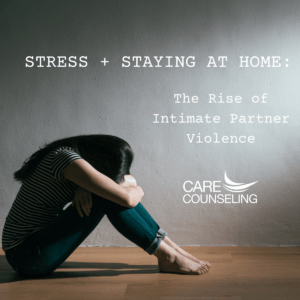 Violence within intimate relationships is on the rise. Increased stress + staying at home + social isolation has helped create a “perfect storm” for violence within the home. Being familiar with the types of abuse that can occur within relationships is an important step to recognizing “red flags” to help yourself and/ or others who are experiencing or have experienced abuse during quarantine.
Violence within intimate relationships is on the rise. Increased stress + staying at home + social isolation has helped create a “perfect storm” for violence within the home. Being familiar with the types of abuse that can occur within relationships is an important step to recognizing “red flags” to help yourself and/ or others who are experiencing or have experienced abuse during quarantine.
Relationship with the abuser does not require sexual intimacy and includes harm through forms of abuse that attempt to gain control by a current or former partner/ spouse. Intimate partner violence is considered a more inclusive term than domestic violence due to violence that can occur among heterosexual or same-sex couples. This can include physical violence, sexual violence, stalking, psychological harm through emotional or verbal abuse, financial abuse, and digital abuse.
According to the CDC, about 1 in 4 women and nearly 1 in 10 men have experienced sexual violence, physical violence, and/or stalking by an intimate partner during their lifetime.
Here is a brief definition of each form of abuse along with several “red flags” for abusive relationships.
- Physical Violence: when a person hurts or tries to hurt a partner by using physical force
- Red Flags: behaviors such as hitting, punching, kicking, slapping, shoving, or choking; use or threat of use of a weapon such as a knife, gun, or another object to inflict bodily harm
- Sexual Violence: when a person forces or attempts to force a partner to take part in a sex act, sexual touching, or a non-physical sexual event when the partner does not or cannot consent
- Red Flags: violation of one’s sexual boundaries; pressure, or coercion to engage in sexual activity; pressure to use drugs/ alcohol before engaging in sexual acts; attempts to control through preventing the use of birth control or pressure into unwanted pregnancy
- Stalking: when someone repeatedly watches, follows, or harasses you, making you feel afraid or unsafe
- Red Flags: stalking one’s home or workplace, constant monitoring by the abuser or associate of the abuser which may include behavior to intimidate and harass one’s children
- Emotional and Verbal Abuse: use of verbal and non-verbal communication with the intent to harm another person mentally or emotionally and/or to exert control over another person
- Red Flags: threats (including threats using one’s pets, family, or children); excessive texting, constant monitoring or “checking in”, intimidation, insults, isolation, “gas-lighting”, placing blame on the victim for the abuse
- Financial Abuse- controlling a partner’s economic resources
- Red Flags: taking away money, refusing or limiting access to financial resources; insisting on shared financial resources then monitoring or limiting all access; creating dependence through preventing work or educational opportunities
- Digital Abuse- use of technology to bully, harass or intimidate
- Red Flags: Stalking through social media platforms, constant monitoring such as checking emails, listening in, and answering private phone calls; attempts to embarrass, frighten, or humiliate on social media; threats of self-harm or suicide due to ended relationship, sending unwanted emails or messages
Red flags of abuse can begin as subtle. A new relationship may move very quickly and feel good “too good to be true” at the start. The partner may be generous with flattery and attention. Subtle gestures to limit social interactions and activities may begin as well as psychological manipulation within the cycle of abuse.
Control. Jealousy. Anger.
Break-up. Make-up. Empty Promises.
Access to resources and support may become limited. You may find yourself feeling afraid and anxious when around your partner or when they call. You may find yourself justifying physical signs of abuse, perhaps hiding bruising.
Individuals in abusive relationships may begin to blame themselves. They may feel scared or ashamed to get help.
Abuse is not your fault! Know where to go for help. Here are some great resources that are available 24/7.
The National Domestic Violence Hotline
https://www.thehotline.org/
1-800-799-7233
The National Sexual Assault Hotline: Include resources for sexual assault, harassment, dating/ domestic violence, and other victims of crime
https://www.rainn.org/resources
1-800-656-4673
Anti-Violence Project: Includes resources for LGBTQIA+ and HIV-positive survivors
https://avp.org/
Crisis Text Line: Text HOME to 741741
https://www.crisistextline.org/
Written By: Charlotte Johnson, MA, LPCC
We’re Here to help
Our wellness experts will be happy to take care of you. You can CLICK HERE to schedule an appointment now or call (612)223-8898.
Meet Clinicians
We’re united by our commitment to providing effective, relevant, and innovative mental health support at all stages of your journey. Click Here to find out more about who we are, where we come from, and how we live out CARE’s mission every day.
The professionals at CARE are actively collecting and creating resources to help with what you need. We’re Here for You.



